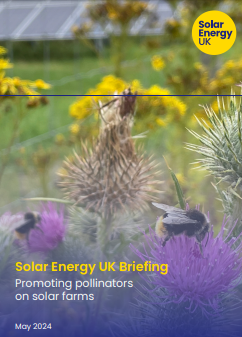Solar farms can promote pollinator biodiversity, including bumblebees and butterflies, through creating a range of microclimates and pollinator-friendly habitats.
Solar farms can promote pollinator biodiversity, including bumblebees and butterflies, through creating a range of microclimates and pollinator-friendly habitats. Creating pollinator friendly habitats can be simple and fully compatible with solar farm operation. Habitat creation can be undertaken between the rows of panels or in margin areas, avoiding interference with electricity production.
- Employing management practices that promote pollinator friendly habitats.
- Enhancing food resources (such as pollen and nectar) for pollinators.
- Providing reproductive resources (i.e. places to nest or lay eggs) for a suite of pollinators.
- Designing and managing solar farms, where possible, to provide pollinators with a range of microclimates, essential for regulating body temperature.
- Taking a landscape approach to pollinator conservation is key and solar farms can help to connect habitats.
Management recommendations
 This briefing presents ten evidence-based management recommendations to support and enhance pollinator populations within solar farms, based on research undertaken at Lancaster University. Recommendations are based on > 400 pieces of peer-reviewed scientific evidence on how land management practices relevant to solar farms can enhance pollinator biodiversity. Moreover, recommendations are grounded in solar farm management practices, align with industry best practice guidance and consider solar farm operation and maintenance needs. Expert ecological advice, including an understanding of the local context, should be sought alongside these recommendations to tailor implementation, given solar farm-specific conditions. Management recommendations are grouped into five key themes: foraging resources, reproductive resources, site management, climate, and landscape.
This briefing presents ten evidence-based management recommendations to support and enhance pollinator populations within solar farms, based on research undertaken at Lancaster University. Recommendations are based on > 400 pieces of peer-reviewed scientific evidence on how land management practices relevant to solar farms can enhance pollinator biodiversity. Moreover, recommendations are grounded in solar farm management practices, align with industry best practice guidance and consider solar farm operation and maintenance needs. Expert ecological advice, including an understanding of the local context, should be sought alongside these recommendations to tailor implementation, given solar farm-specific conditions. Management recommendations are grouped into five key themes: foraging resources, reproductive resources, site management, climate, and landscape.
